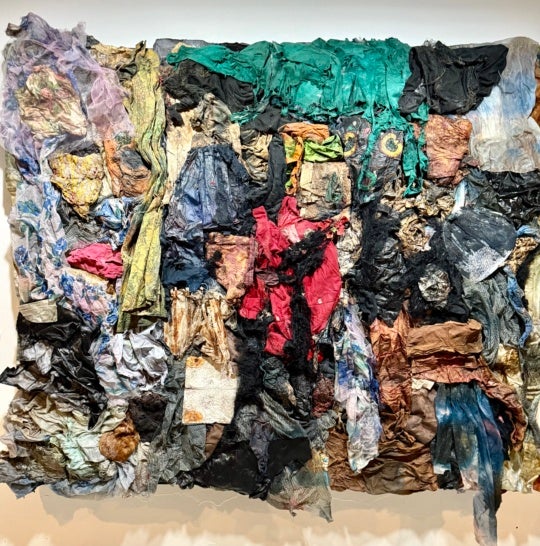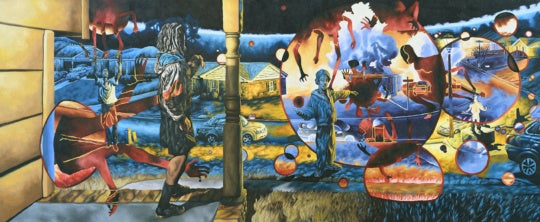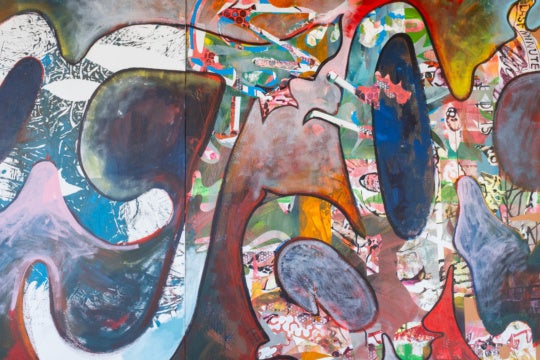
Before entering The Ends, Beep Beep Gallery’s two-person show featuring works by Jason Kofke and Chris Chambers, I could see a black Pontiac Fiero (circa 1984) through the front window, foreshadowing what I would instantly notice upon entering the space: the smell. At first, I thought the scent was of motor oil—it certainly was not “new-car” fragrance—then I realized what it was: the stench of nostalgia. On the surface, the show comes off as a walk down memory lane, a conversation between two artists recreating shared childhood memories by trading on the media and imagery of their glory days; on a deeper level, the show extends a critical view of the world today, and a premonition of things to come.

The Pontiac Fiero was a symbol of coolness in the late eighties, but if my memory of being five years old serves, it was also a sign of douche-baggery. A poor man’s DeLorean, the car was a favorite of first-generation adopters of the mullet (thus probably a lusty cougar to today’s under-40s with second-wave mullets and neo-traditional tattoos). In The Ends, the car’s physical location and intrusive presence makes it the centerpiece of the show. As much as I would have liked to have seen the Fiero restored with all its original parts, the state in which it is displayed in the show tells us a little about the artists’ views of nostalgia: a utopian hodgepodge, largely intact and correct, yet completed by after-market add-ons, including a CD-player (capable of blasting digitally remastered songs from the cassette-tape era), and chrome-plated plastic hub-caps, whose distorted mirrored surfaces reflect our skewed images back to us.

On the adjacent wall, a trio of progressively older MacBooks plays videos. The accompanying audio on one machine, delivered via headphones, acts as the artist statement for the show and didactically reinforces the analogy made by the car. Over the video montage, which juxtaposes truly traumatic events with melodramatic ones, Apple’s robotic, female voice, SIRI, delivers excerpts from Wikipedia, telling us that memory is not exact and that nostalgia is actually emotionally charged memory, implying that although sentimentalized memories may be embedded deeper in our psyches, they are more likely to be tainted. The video, though possibly overly pedagogic, makes for an easier unwrapping of the rest of the show.
In my favorite work from the show, a site-specific multi-channel video installation plays a loop of glitched-out archival footage on a collection of cathode-ray-tube televisions. The video is accompanied by a sound, which is transmitted to the Fiero’s stereo and various clock radios throughout the gallery. (The radio feed is audible on any FM radio tuned to 93.1 if it is in close proximity to Beep Beep.) The installation brings together the strongest and possibly most disturbing connections in the show. Between videos of teenagers living out life’s melodrama and nostalgic sports cars rest two sloppily typewritten texts: transcripts of Ronald Reagan’s public addresses after the Korean Airline Massacre of 1983 and the Space Shuttle Challenger explosion in 1986. The typesetting seems to crumble, solidifying the 9-11 reference to the tower-esque pair of works. The comprehension of this wall of information solicits as many questions, if not more than, the rest of the show combined: most importantly, “What is it that I’m not remembering (experiencing)? What tragic events are occurring while I attend to the performance of everyday life?”

On the opposite wall, both artists display proficient drawing skills with a variety of 2D formats. Due to the self-imposed limitation of industrially standardized media, detecting the difference in each artist’s hand becomes a function of close inspection. Xeroxes and sharply outlined drawings of people, sports cars, and airplanes float on graph paper and ledger grids. I imagine the artists as young boys, wishing they had the technical abilities to draw these objects of desire at their current adult level of skill. At the same time, the variety of imagery, from the fantastical DeLorean to the tragic Christa McAuliffe, exhibits the range of experiences that create deeply emotional memories, all of which somehow end up in the realm of nostalgia.

We live in a novel time when a 30-something can look back on his childhood and see all the technology of his youth as obsolete. With its strong doses of hipstery sentimentality for all things from the 80s and early 90s, Kofke and Chambers’s The Ends struggles to maintain integrity, especially with a perfunctory viewing. Youth culture’s endless affinity for the ironic implementation of Ataris, Cameros, and floppy disks to make cursory statements, such as those found on internet memes and in kitschy t-shirts (not to mention an endless list of gallery walls), stands to hinder delving beneath the surface of this show. But regardless of its hipster-savvy aesthetics, the show posits a series of deeper questions, such as, “Why are we sentimental for technology at all?” Perhaps nostalgia is not based on memories of a time period that was better, but of a time when we were better; the technology of our youth only reminds us of that time. In an email, Chambers stated that he has had similar, visceral feelings from interacting with ‘dead’ technology as when seeing video of friends who have passed. But how long will technology be able to hold this sentimental effect? As our civilization supposedly approaches the technological singularity, a time when technology changes so fast that we humans will have to augment ourselves with machines to keep pace, this show makes me wonder if future generations will have enough time to develop a sentimentality for the things of their past? Will VH1’s Youtube feed be airing “I Love January 2021” in February of 2021? Could, as my editor, Rachel Chamberlain, suggests, a feedback loop develop where we are always instantly nostalgic for ourselves? (Instagram, anyone?)

The odor I smelled when I walked into the show was not nostalgia. Well, not exactly. It was actually creosote soaked rail-road ties, upon which the Fiero was perched. Creosote is a chemical that is derived from the distillation of tar and can be used as a preservative, a fitting metaphor for the distilled childhood memories Kofke and Chambers have preserved in this show. Ultimately though, The Ends is not solely about sentimentality, it is about, as the press release puts it: “The material of the recent past [being] used to communicate an understanding of the recent past and, by default, now.”
Recorded history is a mirror; it functions to augment our memory; it reminds us of the things we wanted to happen differently, and asks us to try to make the right decisions in the future. The Challenger explosion makes us think of the recent end of the shuttle program; the Korean Airline Massacre reminds us of 9-11; the corresponding relationship with Russia mimics our struggles to come to terms with Afghanistan and North Korea. These tragedies together with the attacks of 9-11 remind us of Babel-esque analogies to America. The DeLorean, by way of the Fiero, reminds us of Back to the Future, and the age-old question of whether the future is controlled by destiny: Is the future destined to repeat the past, or can we actually learn from the past and positively affect the future? For me, The Ends shows that the odor of nostalgia is not only the stench of rotting corpses, but also the musk of history books, both of which compel us to actively shape the times to come.
Chris Chambers and Jason Kofke’s The Ends will officially remain up through Saturday, April 28, 2012; though word on the street is that the show may be up for a little while longer. What’s certain is that this exhibition is consistently changing, so if you’ve seen it already, you’re bound to be in for new surprises later. Check out The Ends at Beep Beep Gallery from noon to 6PM, Wednesdays through Saturdays.




